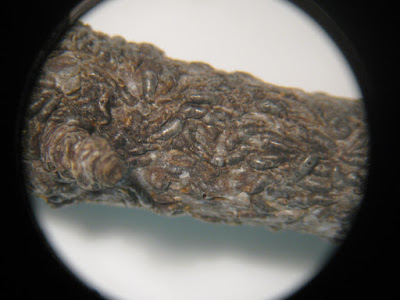I recently discovered scale insects on one of my houseplants. They are on my Anthurium (Flamingo Flower) and are causing the leaves to turn yellow and drop off. I know several of you also have an occasional problem with insects on your houseplants. Today I will cover a few of the sucking insects.
Sucking insects suck the plant’s sugary sap, causing the leaves to turn yellow. Since these insects cannot fully digest all the sugar, they secrete a sticky substance called honeydew. Examples include scale, mealybugs, and aphids. Houseplants infected with these insects will have sticky leaves and sticky areas below the plants.
 |
| Oystershell scale on maple |
Scale insects are hard to see. They are brown or gray in color and extremely small. To the untrained eye, they may be unobservable, or you might think they are part of the plant. Upon close examination, you will notice round, oval, or shell-shaped clusters residing upon the branches and stems of infected houseplants. These clusters (scales) can be scraped off the stem. The insects live under this scale, which makes control difficult.
Scale insects have 3 stages of growth: egg, crawler, and adult. Only the crawlers are easily controlled. Crawlers hatch from eggs and move across the plant. Eventually they lose all their appendages and secrete a waxy covering that forms the observed “shells” which protect the pests.
 |
| Mealybug (in center of picture) |
Mealybugs are more obvious. They appear as small, white cottony balls that cluster at the base of leaves. Since they are small, mealybugs hide at the base of leaves and make control difficult.
Aphids are not as common indoors but do occasionally occur. These also are very small. Aphids are an eighth inch long and come in many different colors: green, pink, red, yellow, brown, or black. In the right situation, aphids build in large numbers, clustering upon new growth and stems.
For all three of these insects, the control methods are similar. Thoroughly clean plant parts with a cloth dipped in soapy water (for example Ivory or Pine sol). Use 1-2 tablespoons per gallon of water. To get thorough coverage, you might even try spraying the soap solution on with a hand-pump spray bottle.
In lieu of making your own insecticidal soap, you can purchase them. Commercial insecticidal soaps include fatty materials and smell like grease. Follow all label directions carefully. I do not recommend anything stronger than soap if used in the home. Repeated applications will be necessary. It also sometimes helps to isolate infested plants.
If the infestation is very bad (and as a last resort), you may need to throw that plant away and purchase a new one.
Originally published in Canton Daily Ledger on 2-3-2001







